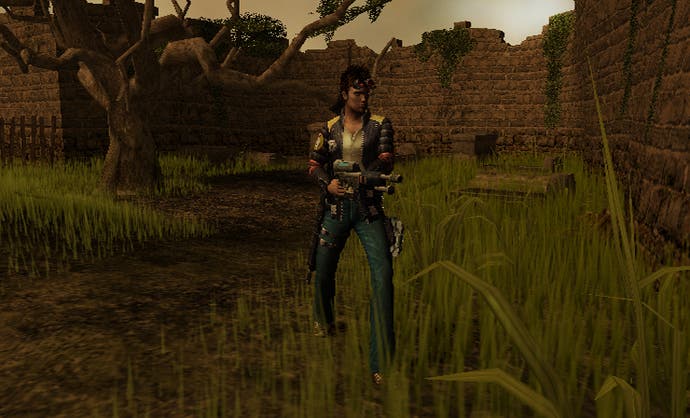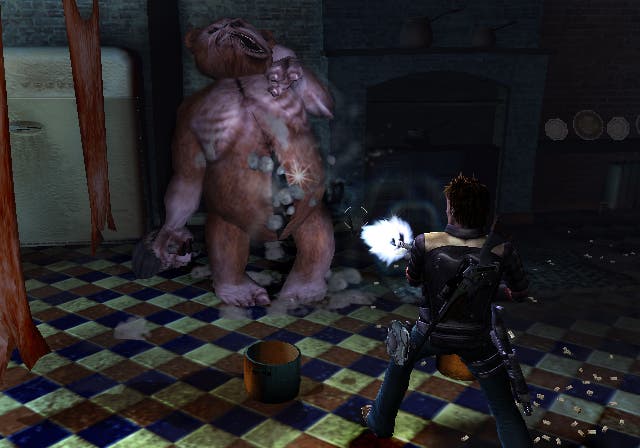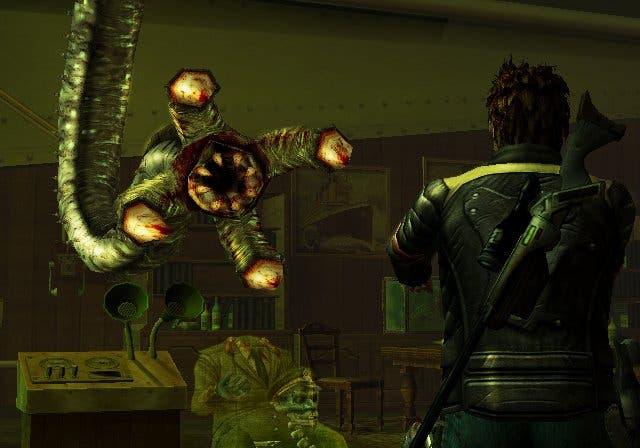Ghosthunter
A stab in the dark.
In the story A Christmas Carol, an old miser named Scrooge is haunted by the ghost of Christmas past. The apparition conjures up imagery of Scrooge's history, trying to show him how the mistakes he made affected others, and how he can avoid them in the future. I'm not sure if the ghost of Christmas past has yet paid a visit to Sony Cambridge, but if he did then it clearly wasn't on one of his better nights. Because, in Ghosthunter, the developer has obviously tried hard to rectify the mistakes it made with Primal - but in doing so has only created a handful of new problems.
In saying that, any game that keeps me up until 3am has to have something going for it. And that something is beauty. Beauty and atmosphere. Whether that's enough to warrant a purchase will be decided by what you look for in a game. In fact, how much you'll enjoy Ghosthunter probably comes down to one question: would you stop to smell the roses, or would you shoot the gardener before he even planted them?
Ghost in the nutshell

You see, in some ways, Ghosthunter is one of the most enthralling games I've played all year. There are moments in it that will linger long in the mind, longer than many games with much better gameplay. On the other hand, it sports an inappropriately clunky combat system, plus some of the most frustrating level design I've forced myself to sit through in ages.
But first thing's first. For those of you who read Tom's preview, you'll know that Ghosthunter is Sony Cambridge's take on the survival horror genre. You'll also know that it uses the same engine as Primal, and that the main character is a brash young cop named Lazarus Jones.
The game's premise is (thankfully) straightforward enough. Jones and his partner Anna Steele are investigating an abandoned school - as you do - when Jones rather irresponsibly sets free a horde of ghosts from a sort of containment tank in the basement. The most evil ghost released, Hawksmoor, immediately kidnaps Steele and it's up to Jones to rescue her. This basically involves Lazarus teleporting to various eerie places, such as a haunted swamp cum ghost town and a spooky prison, in order to recapture the spirits he set free. Helping him along the way are Astral, a ghostly sidekick who you can summon at certain points to aid you, and an AI computer personality that stays near the school's basement (which acts as a sort of hub) and gives you new weapons and instructions.
Gameplay is split into three main camps; exploration, combat and puzzle-solving. The exploratory elements are nothing short of fantastic, but the puzzle sections would test a snail's patience, while the only fighting worth doing in Ghosthunter is against the creeping suspicion that this game has overstepped its limits.
But before you start throwing this into the same (discount?) basket as Primal, one thing needs to be made very clear. Unlike Sony Cambridge's last effort, the problems with Ghosthunter's combat and puzzles, which I will elaborate on in a moment, are not a fault of the engine. Rather, they are a fault of design.
In Primal, Jen's basic attacks - and indeed her very movement - were so clunky and limited that there was little chance of the game ever impressing on that level, regardless of how the developer designed the fights. In Ghosthunter, however, Lazarus actually handles very well. His basic movements are perfectly suited to a survival horror cum adventure game.
For instance, when you're simply walking around, taking in the glorious graphics, controlling Jones is a joy. You make him walk with the left stick, while handling the camera with the right stick. The controls default to an inverted Y-axis, but once you change that in the options the game plays just like any of the best third-person titles out there. The only difference is that the stick sensitivity is fixed at a lovely balance between movement and camera; I found it perfect, but others may not. Another point worth noting is that I relish controlling cameras with the right stick, but anyone who wants to play the game without this hassle will be faced with a very poor AI camera that rarely does what it should. Be warned.
You enter combat (or 'hunting') mode by pressing the circle button. This brings up an aiming reticule onscreen, and puts Lazarus into a typical "hands in the air, now!" cop stance, with gun at the ready. In this mode, the right stick sensitivity is slowed somewhat, allowing for smoother, more accurate aiming, while Lazarus also moves slower, and sidesteps left and right instead of turning. Pressing R1 fires, while holding down L2 changes the aiming reticule to a much more sensitive type - very reminiscent of the 'pinpoint' aiming modes in GoldenEye, Syphon Filter and TimeSplitters 2 - and pressing R2 throws Lazarus' spirit 'grenade', which captures ghosts on contact once they've been sufficiently weakened.
In-spectre gadget

For the type of game Ghosthunter should be, I honestly can't fault these controls. They handle beautifully, and responsiveness and the camera really aren't an issue. The problems lie with the developer blatantly ignoring the system's limitations. For instance, many of the ghosts you'll face in the game move at least five times faster than Lazarus does, both on feet and in the air. This is even worse when you're in hunting mode, which you're obviously going to be using when you're fighting enemies.
Here's an example: you're fighting a chainsaw-wielding revenant, who likes to get up close and personal with Lazarus, carving chunks out of our hero. Every now and then the creature does a kind of dash attack (he's not the only enemy to do that, either; it's a staple of more than a few). If you're in aiming mode - and even if you're not - this attack is nigh impossible to avoid. Lazarus can't dodge left or right and he can't roll; all he can do is sidestep one pace to either side, which isn't enough for the attack to miss. Often, the only way to defeat many a ghost without being hit is to hide behind scenery or pick them off from afar.
Why on earth Sony Cambridge has designed enemies so much more agile than the main character is beyond me. Well, actually it's not beyond me at all - it's obvious that they simply got carried away. The enemies look, sound and are animated brilliantly, but this game would have been so much better if they were just that little bit slower.
A great example of the level design ignoring Lazarus' limitations comes up early on, when some invisible snipers (you heard me) can only be seen by pressing triangle to switch to the first-person view. Your sidekick Astral - who inhabits your body while you walk around - gives you the ability to see spectral elements in this mode, kind of like the heat vision in Rainbow Six 3 and Splinter Cell. Again, it's a nice touch to be able to shoot in this first-person, but unfortunately Lazarus can't move while doing this - something the developers failed to take into consideration.
So you might walk into what looks like a safe area, only to suddenly be fired at from all directions. The only way to see where the snipers are (and to shoot them, with your own zooming sniper rifle) is to switch to first-person, but in doing so you render yourself paralysed and defenceless. Frustrating or what?
Essentially, the developers have forced bog standard first-person shooter enemies onto an engine that was clearly built without such things in mind. So while picking off the slower, less aggressive enemies is plenty satisfying (especially when you successfully capture them with the boomerang-like grenade), most of the combat is simply annoying. Thankfully, at least Sony Cambridge had the sense to make enemy attacks pretty weak, so you're never really in danger of being killed by them. And the fact the fact that they spout both ammo and health just by being shot at makes the process less painful.
It's just a shame that Ghosthunter didn't go down the Silent Hill or Resident Evil route, with slow and rambling enemies, while concentrating more on the game's excellent atmosphere. Because, unlike the cumbersome control in the latter two titles, picking off such enemies in Ghosthunter would have been a joy. Oh well.
Astral la vista, baby

Almost as frustrating are the game's puzzles, especially the ones that involve Astral. She can only be summoned where there's a kind of glowing pentagram on the ground, and when you see one of these you know there's no progressing until she does something. Controlling her isn't nearly as smooth as is Lazarus, mainly because she flies, which necessitates the use of R1 to ascend and R2 to descend. My commendations to the girl - she does a very good job of imitating a drunken swimmer.
As the game progresses, Astral gains abilities when you capture certain key ghosts, including the ability to 'charm' other ghosts, pass through certain walls and become 'solid' in order to push switches and the like.
The thing is, while many of her puzzles are pretty straightforward, there are practically no clues as to what her abilities do or how they work. Now, the copy of Ghosthunter I had was a promo and as such came without a manual, so perhaps all that is explained in the retail version, but nonetheless it still shouldn't cause the kind of problems it did for me. Almost every time Astral's summoning spot appeared on the ground, I knew I was in for trouble. It didn't matter if the puzzle was as simple as making Astral solid so she could flick a switch; the game is so vague in pointing you in the right direction that just figuring something like that out can take ages. On top of this, Astral only ever has a limited amount of 'energy' to perform abilities, so if you run out of energy trying to figure something out, you have to return to Lazarus, find more ammo energy (same stuff) and then summon Astral again. Rather stupidly, every summon spot has rats running around it, which you can shoot for this energy. But I ask you, what's the point in 'draining energy' if it's available to infinity where she's summoned anyway?
It's worth noting that one particular puzzle in the Swamp Mansion (you'll know it when you get there) remained unsolved for five hours. Five bloody hours. If it wasn't for a walkthrough on GameFAQs I would have been forced to abandon this review. It was that inane.
In saying that, some of the puzzles were actually fairly satisfying and not too much hassle to complete, but the ones that I couldn't figure out are the ones that stand out. Lazarus does mark notes in a 'diary' that are supposed to give clues, but only one of these ever helped me.
Lighting the way forward

So, to recap, playing Ghosthunter basically comprises slowly progressing through areas, picking off enemies and solving rudimentary (in theory, at least) puzzles, many of which involve enemies anyway. Why then, after complaining so much about the design, have I given Ghosthunter a reasonable score below?
That's easy; it looks, sounds and feels awesome. Quite simply, there are times in it where I have never seen anything so impressive in a game. Sure, Primal was amazing too, but Ghosthunter is another step above it again. As you'd expect, things like texture detail and animation are superb, but it's not these aspects that steal the show. Rather it's the combination of breathtaking lighting and wonderful art that do the trick. We've known for a long time that perfect lighting is the key to realism, but so far much of its use has been in contrasting brightness and darkness, rather than enhancing colour. In Ghosthunter, there are certain scenes that made me stop playing and mutter 'my god' to myself. One room in the Swamp Mansion (not that room... I hate that room) has one of those night-time lamps for putting babies to sleep, and it casts different-coloured light shapes all over the walls. Absolutely stunning.
But what really makes the difference here is that, unlike Primal, the developers actually have a decent use for the graphics in Ghosthunter. In the moments leading up the room I just mentioned, things had been getting very weird indeed, with strange imagery suddenly littering the halls (like alien babies floating in green tanks) and that eerie girl from the TV ads leading me down a merry path. Add to this some excellent music and sound effects, and the experience was quite surreal. It's probably fair to say that the game doesn't quite live up to this standard of imagination in the prison and base levels, but the journey is one well worth taking regardless.
You see, it should be remembered that even though Ghosthunter shoots itself in the foot with terrible combat and poor design, its main goal is to immerse the player in its world and its atmosphere. On that level, it does a very good job indeed. Forget the fact that Sony Cambridge are credited with making games that are nothing more than 'tech demos' - if credit is due, then credit is due. And in this case, it is. The best compliment I can give the game on this level is that despite some horrid moments that made me want to give up on it for good, I still played to the end - just to enjoy the experience.
This might come back to haunt us...

So Ghosthunter once again raises the 'aesthetics versus gameplay' debate. It sports a stunning-looking world that's comfortable and satisfying to explore - much more so than Primal was - but for some reason the developer has tarnished this with a god-awful set of enemies and infuriating level design.
If you're the kind of gamer that enjoys immersive, atmospheric graphics and a surreal world to explore, then you might well find the patience to plough through Ghosthunter's many faults. Hell, you might even enjoy some of them. If you lean (very, very) heavily in this direction, you could even add a point to the score below, because when 'exploring' I cannot fault the comfort of the controls or the aesthetics.
However, if top quality production levels and 'arty' games don't do it for you, if decent gameplay is your bread and butter (as it should be in most cases), and if you're the kind of person who spits on the Silent Hill and Resi games because the atmosphere just doesn't do it for you, then feel free to deduct two marks from the score below. Because, despite all its huffing and puffing, Ghosthunter only ever manages to frustrate.
And for those of you who wonder how a game can score a difference of three marks dependent on what kind of gamer you are, I only have this to say: the game is that good on some levels, and that bad on others.
I need a drink after that... Wait a second, where have all the spirits gone?
